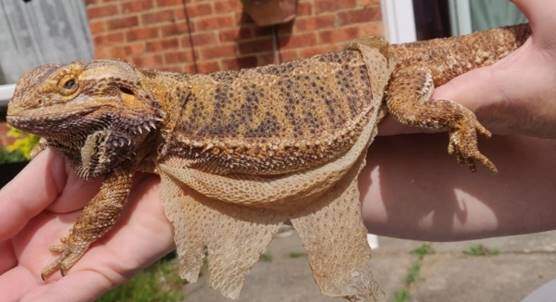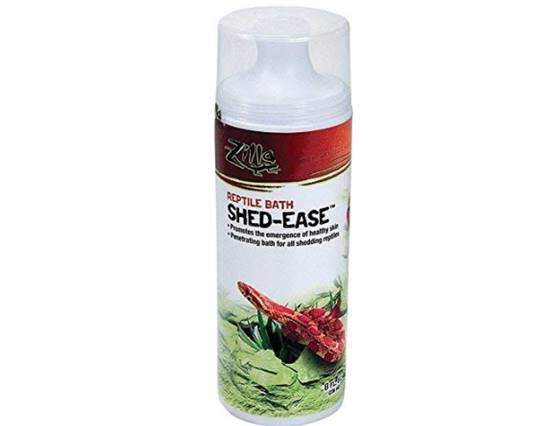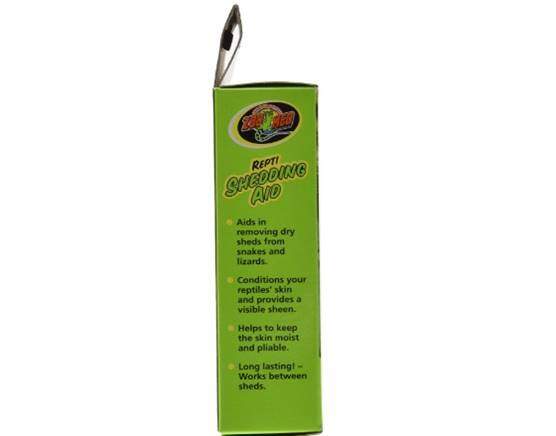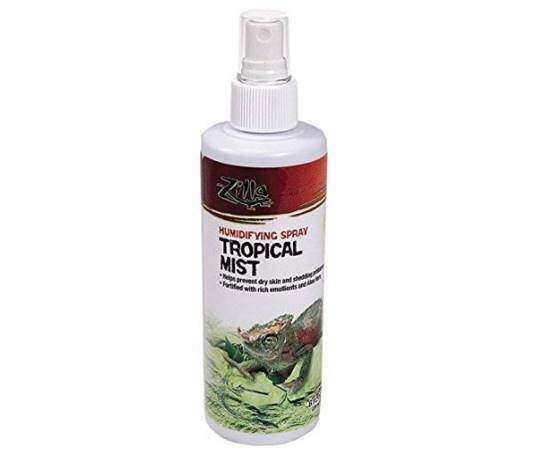Shedding, molting, sloughing, ecdysis is the process of the casting of the old outer skin once a new inner one has grown. Researchers consider this process to hormone controlled, and it is due to the need to increase in size. i.e., your pets will have outgrown their older skin.
Besides growth, it helps in eliminating parasites in case of any, and once they complete shedding, the emerging new skin will have more colorful skin as opposed to the dull one cast off, and it will free of any parasites.

Besides having more vivid colors, the new skin is more efficient in vitamin D3 synthesis (necessary for calcium absorption) as well as in absorption UV rays.
Unfortunately, immediately after the shedding, the new skin more permeable and calls for a reduction of any toxic products you may have been using to control parasites, including mites, as their skin will absorb them.
Why does this peeling occur?
As with any other animal, including human beings, skin cells continually die. Soon after they die, new cells will replace the dead ones. However, unlike humans who regularly shed their dead skin cells, some reptiles will slough dead skin at a certain point, all at once and not continuously like humans.
Keratin makes up these reptile’s skin is inelastic, meaning as they grow, it can no longer cover their entire body. Soon it will be too stretched and start coming off.
When does the molting occur?
Besides some signs that your bearded dragon may show, there is no way to know when it will occur. Furthermore, there is no regular pattern they follow, but these factors may influence its happening:
- Diet
- Growth
- Health
- Breeding
- Habitat and environmental factors such as humidity, temperature, UV light, and so on.
Do baby bearded dragons shed?
Yes. Baby, juvenile, and adult bearded dragons shed off their skin. However, since they are growing faster, younger or baby bearded dragons shed more than older ones.
The younger they are, they more often they will shed, and this drops gradually. For instance, most baby and juvenile beardies will shed after every 6-8 weeks or less time. However, once they are a year old, the rate at which it occurs will gradually drop, i.e., as they mature, there will be a reduction in the number of times that sloughing occurs.
Usually, adults have the slowest rate of molting. Under ideal conditions, expect them to molt about 1-2 times in a year. Furthermore, their sloughing is slightly different as it occurs more in patches and not uniformly like in baby beardies.
Finally, if your breaded dragon is not shedding, there is no need for alarm. Just leave them alone. They will do so at the right time. Remember, adults can take up to a year.
Shedding behavior and signs
There is no way of telling when your bearded dragons will shed. However, when they are about to, your beardies may show the following signs and behaviors.
- Have a dull or a darker color
- Hide more than usual
- Eat less food than usual with some not eating at all.
- Being cranky or not willing to be held, i.e., they will no longer be laid-back. Instead, these lizards may have a skittish temperament.
- Raised skin patches
- These pets will time and again bulge their eyes to help loosen the skin around their eyes.
- Scratching their body and rubbing against objects.
- A few beardies may be lethargic
- Restlessness
Some of these signs, such as hiding more and not eating, may indicate that your pet is about to brumate. Ensure you carefully assess their skin for apparent symptoms.
Shedding process
Once the inner skin has grown well (epidermis), they release enzymes to help loosen the old top skin that will be adhering to the new inner one.
Unlike snakes and some insects where the skin or exoskeleton comes out in one piece, in bearded dragons, it occurs by small pieces of their skin coming out. Their shape will not allow for it to come off in one piece entirely. Sometimes, it can occur in patches.
When they begin molting, your pet will scratch their body with their legs to help loosen the skin or get it off from their body.
Also, they will rub itself against rough objects, including their basking rock, climbing tree or logs, or any other furniture that has a hard surface. This rubbing will make their stretched skin to break and peel off.
Beardies eating their skin as they shed
As the skin comes off, some bearded dragons may eat it. There is no problem with this as their skin has a lot of calcium. Unfortunately, such behavior may be an indication that your lizards don’t get enough calcium. Always ensure they have calcium and multivitamin supplements.
Furthermore, their skin may be unhygienic as it may be having parasites, fecal matter, and any other decaying matter, including their food.
How long does ecdysis last?
Once the sloughing process has begun, expect it to last for up to 2 and 3 weeks in adult beardies while in young ones, it will happen much faster, a few days to about a week.
However, there are a few things you can do to hasten this process and make it happen more effectively, which we are going to look at later.
Can I remove bearded dragon stuck shed?
Although there are many ways you can help this agamid lizard shed more effectively, you shouldn’t pick or peel any stuck skin as this may be painful. Besides the discomfort, it will cause, doing so may peel off or damage the newly growing skin layer.
Helping your beardie shed
While there are beneficial shedding aid products we are going to look afterward, they shouldn’t be your first choice since there are more straightforward, cost-free ways to do so.
Remember, while in their natural habitat, things such as rough outcrop surface, branches, rocks, and so on aid in peeling the skin off their body. Unfortunately, this isn’t the same case if you look at a vivarium environment, and you need to help these pets shed well.
Besides keeping optimal habitat conditions, including temperature, UV light, and humidity common ways to promote this process include:
1. Right diet
When feeding your bearded dragon, you need to ensure they have balanced diets even when they are not shedding. Feeder insects like roaches, mealworms, silkworms, crickets, grasshoppers, and so on are a good source of proteins, fats, and other nutrients. Besides, give them veggies, some safe plants, and fruit treats.
Finally, don’t forget to dust their food with multivitamins and calcium, vitamin D3 that has vitamins, minerals like magnesium, and calcium as they do help in shedding. Zoo Med Repti Calcium with D3 is a good source of calcium and vitamin D3 and multivitamins like Rep-Cal Herptivite Beta Carotene Multivitamins will work well.
2. Proper hydration
Ensure your bearded dragons have enough drinking water. Always refill their drinking bowls once they empty them and replace the drinking water daily. When adequately hydrated, they shed more effectively.
3. Baths
Giving 10-15 minutes baths in lukewarm water will help not only in keeping these pets hydrated as they will drink some water but also help boost sloughing. Use a shallow tub in giving the baths and do it a few times in a week.
Besides giving them baths, you can also place a shallow water tub inside their terrarium. Some may lie inside the water, and this will aid in shedding.
Finally, swimming and bloating their skin with a damp paper towel may also help keep their skin moist and foster proper sloughing.
4. Misting
If they don’t like baths, you can sprinkle their body with water. The wetting will help in ecdysis. Furthermore, it encourages these pets to drink the water drops that fall on their snout and hence better hydration.
However, as you do so, ensure you don’t raise their vivarium humidity beyond the tolerable levels. High moisture content in the air they breathe can potentially cause various respiratory illnesses.
5. Textured furniture and décor and a suitable substrate
Having climbing rocks, branches, a rough substrate type, stakes, and so on will give this pet a place to rub as well as entangle or trap some loose skin. Besides, consider adding sandstone slabs or any other textured safe items.
A substrate choice can aid in shedding. Smooth substrates types like newspapers, paper towels, and so on may not in peeling the skin off as those that are rougher.
6. Rubbing with a soft toothbrush
Shedding should last for at most two weeks. If it goes beyond, you can gently stroke their body with a soft toothbrush such as the one for kids.
Problems – not shedding well or dysecdysis on tailor toes
Sometimes, wrong habitat conditions, diets, missing digits, and other factors may impede normal shedding. In such a case, you will notice remnant skin on areas such as toes and nails, on tails, belly, legs, top of their head, among other places.
Furthermore, incomplete dysecdysis can happen if there is skin damage by tumors, injuries, parasites, and so on. Skin damage will prevent peeling. If their skin is infected, soaking it with dilute betadine or applying manuka honey may help heal the infections.
Since it will shrink once it dies, the old skin may restrict normal blood flow to these areas and can result in tissue death (necrosis) as well as become a site for infections.
Signs of restricted blood flow to the tail include abrupt color change, looking wrinkly, has round rings made of skin that hasn’t come off, among others.
In the case of remnant skin such as on the tail, massage it with aloe vera or pure cocoa butter as it will help boost blood circulation as well as enhance shedding, advises Reptile.guide. However, unless they have broken skin, being impervious, these products may not help much.
Try keeping humidity as usual
Unless they go to their burrows where moisture may be lower, don’t raise their humidity. Exotic Direct advises a raise of tank humidity to 80%. While this will certainly aid in shedding, these lizards thrive in low humidity habitat, and higher humidity may result in respiratory illnesses.
Best beardie shedding aids
Not everyone supports the use of these sloughing aids. However, this doesn’t discount them entirely. They may become handy in some instances, especially when your pet is having trouble sloughing. Here are brands to try.
1. Zilla Shed-Ease Reptile Bath
This brand has a formation that has several emollients as well as aloe vera. It will do two this. First, help in shedding by making the old skin soft and easy to slide off. Secondly, it will ensure the new skin that grows is healthy and lustrous.
Also, besides the two roles, use it on your lizards if they live in areas that don’t have the required humidity level or those that don’t get proper diet or living under stress. It will help improve their appearance as you try to correct whatever is not right.
Finally, it is highly rated, has many happy users, and it will fulfill the promise of easy shedding and a vibrate looking skin after shedding.

2. Zoo Med Repti Shedding Aid
Not just for lizards but also snakes, the Zoo Med Repti Shedding Aid is an excellent alternative to Zilla Shed-Ease Reptile Bath. Its extended-lasting formulation will make shedding easy and will condition their skin, give it sheen, make it flexible and moist.

You are going to love its efficiency and how well it conditions your beardies’ skin. It is a true value for your money.
3. Zilla Tropical Mist Reptile Spray
While it may seem like a product for tropical pets, you can use it to promote shedding and prevent dry skin. It has aloe vera, vitamins and emollients to improve your bearded skin appearance and coloration.

Use it only during shedding and ensure your terrarium humidity remains within the acceptable range.
